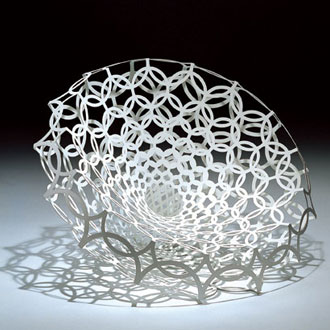And in many respects this is all true. Danish design continues to be recognized for its creativity, innovation, clean simple designs and functionality. But the suggested reading, "Danish design in as old chair," by Sune Aagaard complicated the Ministry's glowing overview. Aagaard argues that in many ways, the Danish Golden Age overshadowed today's designers by being constantly compared to designers of the past. The irony of the situation is that although Golden Age designers were mindful of craftsmanship traditions and often looked at great designs of the past, they nevertheless made a definite break from past conventions. And it was this break from the past that allowed them to achieve such greatness.
 Veryround Seat, by Louise Campbell - cutting edge Danish desiger but is she still overshadowed by those who came before her?
Veryround Seat, by Louise Campbell - cutting edge Danish desiger but is she still overshadowed by those who came before her?http://kulturabivanja.files.wordpress.com/2008/10/louise_campbell_veryround_armchair_amo.jpg
So I began to wonder. Why were designers in the 1960's and 1970's able to make such a big break while designers today are often trapped by the past. Granted, the 1960's and 1970's are marked by cultural upheaval, unconventionality, and a belief that the status quo should be broken. But today's society, while possibly less radical, is nevertheless characterized by a drive to perpetually more forward and move faster. What then prevents Danish designers from breaking away with their design heritage?
The Ministry suggests that one of the driving forces of the Danish Golden age was the post-war values of democracy and humanism (2). I don't think there has been anything comparable to WWII in the last few decades to produce such a profound shift in world perception. But Aagaard explains that unlike in the mid 20th century when furniture and product design was the arena for design innovation, today's design fronts are more technologically based:
"A wide variety of new disciplines within design, many of them closely related to technology, are developing rapidly. A parallel development is taking place within immaterial design, e.g. design of information processes. And in these areas Danish design and designers have not managed to establish a strong position."
Perhaps then, the reason why Danish designers today are not considered to be as great as Golden Age designers is because the field they are focusing in is simply not as prestigious as it once was. More than anything, today is a technological and informational age and so, if Danish designers want to achieve the greatness of those who came before them, they need to concentrate in the field that will allow them to do such. Aagaard even hypotheses that if the designers of the Golden Age were around today, they would be "involved in technology design," because of "their desire to take what is known one step further". In the golden age, this meant bending wood, experimenting with plastic and other inorganic materials. But today technology design surpasses furniture and product design.
 Danish designer Hân Pham's Antivirus design turns an empty soft drink can into a safe depository for dirty needles - 2007 Index: Award Winner
Danish designer Hân Pham's Antivirus design turns an empty soft drink can into a safe depository for dirty needles - 2007 Index: Award Winnerhttp://7335.virtual.yourshelter.net/images/article_images/article_image_66.jpg
The end of the Ministry of Foreign Affairs factsheet mention's the emergence of medical technology design and environmentally friendly deign. I believe it is fields like these, fields that are conscious of the current social and political world, that will allow Danish designers to rise to the level of prominence as the Golden Age designers. Areas like these and others still provide the opportunity to be respectful of tradition in the sense that knowledge, craftsmanship and functionality will all be stressed. But just as the Golden Age designers were able to distinguish themselves from the designers before themwith their innovate aesthetics and materiality, designers of today will stand out as pioneers by improving our world, not with chairs and light fixtures, but with better hearing aids and faster information processing systems.
Click here to view a short video on one of the 2009 Index Award Winners. The project, PIG 05049 tracked the products produced from a single pig to help consumers understand what goes into the process of producing food and a variety of many unexpected products. The project is an example of how design can be used to help understand and explore information and technology in today's society that is often not understood by the average citizen


No comments:
Post a Comment